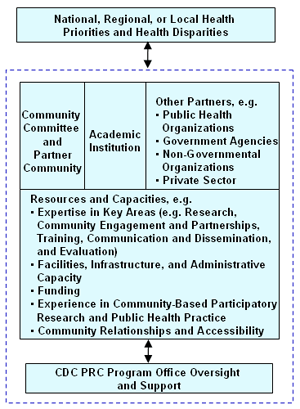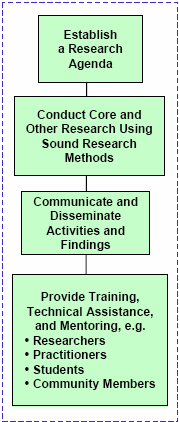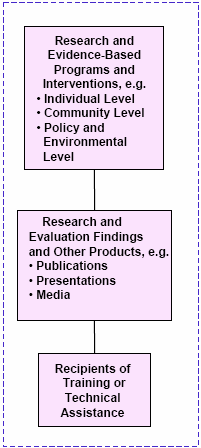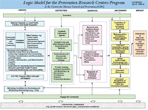Description of the Logic Model for the Prevention Research Centers (PRC) Program
Revised July 17, 2008
Logic Model for the PRC Program
Logic Model Diagram (PDF-82K)
The logic model for the national PRC Program was developed to describe the activities of the program and the outcomes it expects to achieve. The model identifies the inputs, activities, outputs, outcomes, and impact common to all PRCs and shows the expected relationships among these components. The diagram of the model summarizes how the program is presumed to work. Although the boxes of the model are shown in a linear fashion, the relationships among them are expected to be complex and interactive over time.
The national logic model does not imply that one size fits all. To reflect uniqueness, each PRC creates its own logic model by tailoring the national model to the center’s specific activities and goals. More mature PRCs, for example, may be more likely to have a larger array of outputs and outcomes than new centers. The national model cannot show the emphasis an individual PRC may place on one type of activity over another. In addition, the time required to achieve different outputs may vary among PRCs and depends on many factors, such as the type of research conducted and other activities undertaken, the amount of resources devoted to activities such as dissemination, and contextual factors. Thus, the national model does not specify the time it may take to achieve outputs or outcomes.
The national logic model was created through a participatory process involving a diverse set of national, state, and local PRC stakeholders. The elements of the model and its linkages are consistent with the program’s Congressional authorization, the PRC Program Strategic Plan, and the PRC Core Research Projects Policy Statement.
Diagram Note
The size of the boxes in the diagram depends on the amount of text in each box and does not denote the relative importance of a specific element.
Inputs

The first column of the logic model, inputs, refers to the assumptions underlying a program and the infrastructure that must be in place before a program can be implemented. The seven inputs the model captures are described below.
National, Regional, or Local Health Priorities and Health Disparities
Each PRC is established to address national, regional, or local health priorities and health disparities within a partner community or a defined population. A PRC focuses its research activities on the health issues of high priority to the defined community and that address state or national health priorities, such as those stated in Healthy People 2010, or gaps identified in the Guide to Community Preventive Services or the Guide to Clinical Preventive Services.
Diagram Note
A two-way arrow connects the health priorities and disparities box and a dotted line box that surrounds the next five input boxes.
Community Committee and Partner Community
CDC requires each PRC to form a PRC Community Committee (also called a Community Advisory Board or Community Advisory Committee by some PRCs) and to partner with a specific community. The partner community represents the individuals and partners who are involved in or who are the focus of the PRC’s work. PRCs may have more than one partner community. The community committee comprises members of the PRC’s defined community and representatives of agencies and organizations serving that community. The inputs provided by a PRC Community Committee include guidance, expertise, contacts, and related benefits. Some PRCs form additional advisory groups, such as a policy board or advisory committees for individual research projects. The decision to form these other groups depends on the needs of the PRC and the community.
Academic Institution
Each PRC has a core group of multidisciplinary faculty and staff that lead, manage, and implement the various PRC activities as well as additional faculty and staff who collaborate on various PRC projects. All faculty and staff who are associated with the PRC comprise the academic institution partners.
Other Partners
Each PRC is expected to form partnerships within a variety of public and private sectors that includes public health partners (e.g., state and local health departments, CDC, NIH, and public health advocacy organizations), government agencies (e.g., education agencies, transportation), non-governmental organizations (e.g., other academic institutions and state, local, and community organizations), and the private sector. Many of these partners include entities that complement public health work (e.g., worksites, schools, parks and recreation, or housing). Partnerships help make the PRC’s research and capacity-building activities relevant to its identified community. Partners collaborate with the PRC in designing and implementing research and other PRC projects. They also participate in disseminating research findings, which help facilitate the translation of public health research into practice.
Diagram Note
The boxes for community committee and partner community, academic institution and other partners have borders touching each other to reflect that they are the major stakeholders and collaborate with each other to implement the PRC Program. The input box for resources and capacities is connected across the bottom of them.
Resources and Capacities
Before conducting specific public health research projects and health promotion activities, a PRC must have certain resources and capacities. These resources and capacities are brought to the PRC by all partner groups. First, the capacity includes human resources who have the requisite expertise in the key areas of the PRC (research, community engagement and partnerships, training, communication and dissemination, and evaluation) as well as other skills such as grant-writing and human subjects protection. Additional resources and capacities of a PRC are facilities in which to work, an infrastructure that includes data systems, administrative capacity to manage the center, financial resources, and support from the PRC’s academic institution. Other key resources include experience in community-based participatory research and public health practice, access to the community, and relationships with the partner community.
CDC PRC Program office Oversight and Support
The PRC Program office at CDC has the responsibility of managing the PRCs and the program overall. Staff at the CDC PRC Program office undertake a variety of activities, such as providing assistance with the fiscal management of federal dollars allotted to each PRC, monitoring PRC progress, providing technical assistance, evaluating the national Program, facilitating networking across PRCs, developing dissemination materials, maintaining and updating the CDC PRC Program Website, responding to queries, educating partners about the PRC Program, and exploring opportunities to work with existing and new partners.
Diagram Note
A two-way arrow connects the dotted-line box around the previous five inputs to the final input. A one-way arrow connects the dotted-line box around the previous five inputs to a dotted line box around the four activities.
Motivating Conditions for Developing and Maintaining Relationships
The logic model recognizes conditions that motivate the development and maintenance of relationships with community partners and others. These conditions may include tangible or intangible benefits (such as access to expertise or acceptance by a community) gained from the partnership, and perceived or earned trust. These conditions may influence a partner’s willingness to form a relationship with the PRC, the nature and strength of the relationship, and a PRC’s ability to sustain the relationship over time.
Activities

The second column of the logic model describes activities of the PRCs, which include establishing a research agenda, conducting research, communicating and disseminating activities and findings, and providing training, technical assistance, and mentoring. The activities column also includes two overarching activities of a PRC: The evaluation box and the engage the community box.
Diagram Note
The next four activities are inside a dotted-line box and a line connects one box to the next box.
Establish a Research Agenda
The research agenda addresses the identified health priorities or disparities and outlines research to meet community needs. The research addresses knowledge gaps or moves existing research in new directions.
Conduct Core and Other Research Using Sound Research Methods
PRCs are expected to conduct community-based participatory research (CBPR) in underserved communities to prevent disease and promote health. The PRC Program conducts various types of applied research: 1) determinant research, which examines how risk and protective factors affect health and how this research is essential for developing effective interventions; 2) intervention research, which examines the effectiveness of strategies or programs in reducing disease and promoting health; and 3) dissemination research, which examines strategies for promoting the adoption and maintenance of effective programs. Some PRCs’ research activities also include secondary analysis to inform future community programs, interventions, and policy. CDC funds one or more core CBPR project at each PRC and, in addition, some PRCs conduct CDC-funded Special Interest Projects (SIPs). PRCs may also conduct research funded by other federal agencies (such as the National Institutes of Health), state agencies, community-based organizations, or foundations. All research is expected to be conducted using sound research methods that further the field of prevention research.
Communicate and Disseminate Activities and Findings
PRCs also communicate and disseminate information to their partners, the scientific community, community partners and members, academic institution leadership, policy-makers, and others. They provide information about the center generally and its activities, research findings, and other outcomes. Communication and dissemination to key partners and policy-makers during research development and implementation engages these partners in the research and provides a platform for future translation of the research findings or effective interventions into public health practice.
Provide Training, Technical Assistance, and Mentoring
PRCs also provide training, technical assistance, and mentoring to health professionals, researchers, practitioners, students, community members, and others. These activities, which are expected to be developed in collaboration with the recipients, may cover a range of topics, including health promotion, community building, research, and evaluation as well as other needs identified by PRC partners. PRCs may also train and provide technical assistance to community partners for implementing specific prevention and health promotion interventions, including best practices.
Diagram Note
The Engage the Community box runs across the bottom of the logic model, under the inputs, activities, outputs, and outcomes columns, with one-way arrows that connect the box to each column.
Engage the Community
The PRC engages the partner community as part of the overall PRC’s work and the CBPR process. The partner community includes the many partner organizations that work with the PRC. The arrow to each column means the community is engaged in all aspects of the PRC. In particular, the arrow to the motivating conditions box indicates that activities around engaging the community provide feedback to these conditions that influence partner relationships. For example, in the core research project, stakeholders within the defined community are involved in identifying research priorities, selecting projects, recruiting research participants, refining research methods, developing interventions, conducting research, and reporting and disseminating research findings. The community is also engaged in outputs (e.g., co-authorship of journal articles or ensuring that results are presented back to the community) and outcomes (e.g., helping to disseminate evidence-based programs or obtaining funds to continue the implementation of public health programs in the community).
Diagram Note
The Evaluation box runs across the top of the logic model, over the inputs, activities, outputs, and outcomes columns, with one-way arrows that connect the box to each column.
Evaluation
Evaluation is a part of the PRC Program that extends across the inputs, activities, outputs, and outcomes, but not across the final impact column. The one-way arrow to each column indicates that the PRC Program evaluates aspects of each component, guided by performance monitoring and evaluation questions. Evaluation provides useful data and feedback. For example, data may include information about how inputs are used to shape the PRC Program, which activities are undertaken by the collective program, the quality of the activities, and the specific outcomes the program accomplishes. CDC, PRCs, and other stakeholders can use evaluation findings for many purposes, such as modifying program activities or enhancing and strengthening relationships with community partners. Evaluation findings also provide information that can be shared with external stakeholders, can help document the program’s value, and may provide justification for continuing or increasing program funding.
The PRCs are not likely to evaluate impact directly since many factors can contribute to the impact box. The impact may be outside the direct influence of the PRC and the data needed to demonstrate a causal link between PRC research and the long-term reach on community and population health or disease prevention may be lacking.
Diagram Note
One-way arrows connect the dotted box around the activities to the first two outputs (interventions and findings; see below). A separate one-way arrow connects the dotted box around the activities to the third output box, which represents recipients of training or technical assistance. Lines connect the following three output boxes, and they are surrounded by a dotted box.
Outputs

The third column captures outputs generated or produced as a result of the PRCs' activities. The outputs are the measurable products of the PRC Program, as described below.
Research and Evidence-Based Programs and Interventions
PRCs produce research and disease prevention or health promotion programs or interventions in a community. The PRCs’ research requires strong data in order to be evidence-based. The programs and interventions could be implemented or aimed at the individual-, community-, or state-level; involve policy or environmental change; or include a combination of these.
Research and Evaluation Findings
Another type of output includes Research and Evaluation findings (many of which are directly related to the PRC's core research).These findings are typically published in peer-reviewed journals, books, and technical reports. They may also be presented to various audiences at professional conferences, community meetings, or other settings, or reported to the media. Findings from research conducted with a community should be shared with community partners. PRCs also produce other products such as a curriculum or a health promotion tool used in training or other activities, which can sometimes be packaged and made available to interested organizations or individuals. Other types of disseminated products include videos, newsletters, fact sheets, etc.
Recipients of Training or Technical Assistance
Outputs resulting from a PRC’s training or technical assistance activities include the number and duration of training or technical assistance events, the number of trainees and recipients of technical assistance, the knowledge and skills gained from the training activities, and participant satisfaction with the training or technical assistance.
Diagram Note
A one-way arrow connects the dotted box around the outputs to a dotted box that surrounds the six outcomes. These six outcomes connect to each other by two-way arrows.
Outcomes

The fourth column of the logic model includes the outcomes, or the intended effects of the program activities. PRCs can vary in the order in which their outcomes occur.
Translation of Research to Practice and Policy and Widespread Use of Evidence-Based Programs and Policies
An expected outcome is the uptake of research that results in changes to public health practice and policies. Research conducted by the PRCs is expected to be translated into community practice or policies adopted by local and state health departments, schools, other public agencies (e.g., recreation departments, housing authorities), and community-based organizations. Over time, these interventions and policies may be disseminated beyond a PRC’s defined community and gain widespread use.
Enhanced Community Capacity for Health Promotion and Disease Prevention
One purpose of the PRC Program is to build capacity for public health practice. Therefore, an expected outcome is enhanced community capacity for health promotion and disease prevention. Enhanced capacity includes an increased ability on the part of agencies and organizations to implement and make well-reasoned decisions about effective health promotion and disease prevention programs and services. This capacity combines a community’s commitment, resources, and skills to respond to public health needs and priorities.
Skilled Public Health Professionals and Community Members
An expected outcome of the PRC Program is the development of skilled public health professionals and community members. Those who collaborate with PRCs to implement research projects and who participate in PRC-sponsored training and technical assistance improve their skills as a result, and are better able to implement effective programs and interventions.
Expanded Resources
Over time, as a PRC reaches its goals and outcomes, the center can grow beyond the core funding and initial faculty, staff, and partnerships. New projects and funding complement or build on the PRC’s core research or expand the center’s work into new areas.
Increased Recognition and Support
A PRC may gain local, regional, or national recognition from a community or organization for expertise in a particular field, for contribution to a public health topic or practice, or for its involvement with a community or partner. Recognition and dissemination of the PRCs’ work can lead to increased support for the PRC Program and prevention research overall.
Diagram Note
One set of dotted lines group the boxes for the outcomes. The outcomes flow back through motivating conditions and up the input column through a one-way arrow. They also connect to health priorities and health disparities and down the input column through a one-way arrow. These groupings show the potential relationships with other components of the model with which they are logically connected or which they are likely to influence or be influenced by. A one-way arrow connects a dotted line around all six outcome boxes to the impact column.
Impact

The last column of the logic model, impact, is defined as the future, long-term change the program is working to create, or the ultimate goal of the PRC program.
Improved Community and Population Health and Elimination of Health Disparities
As shown in the one box in the impact column, the ultimate goal of the PRC Program is to contribute to improved community and population health and to eliminate health disparities. The work of the PRCs contributes to this impact along with the work of many other partners and programs.
Contextual Conditions

The box across the bottom of the entire logic model implies that there
are contextual conditions, such as socioeconomic, political, and cultural
factors, that are external to the PRC Program and may not be within its
control, but these conditions may influence the implementation of activities
and the achievement of outcomes. These conditions may relate to all
components of the model, as shown by the one-way arrows that lead to each
column of the logic model (i.e., inputs, activities, outputs, outcomes, and
impact).
![]() One or more documents on this Web page is available in Portable Document Format
(PDF). You will need Acrobat
Reader (a free application) to view and print these documents.
One or more documents on this Web page is available in Portable Document Format
(PDF). You will need Acrobat
Reader (a free application) to view and print these documents.
- Page last reviewed: July 18, 2008
- Page last updated: July 18, 2008
- Content source: Division of Adult and Community Health, National Center for Chronic Disease Prevention and Health Promotion
Get email updates
To receive email updates about this site, enter your email address:
Contact Us:
- Prevention Research Centers
4770 Buford Hwy, NE
MS K-45
Atlanta, GA 30341-3717 - cdcinfo@cdc.gov


